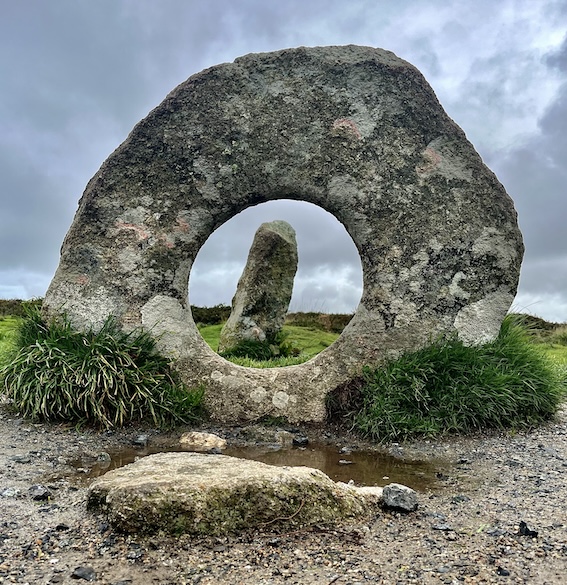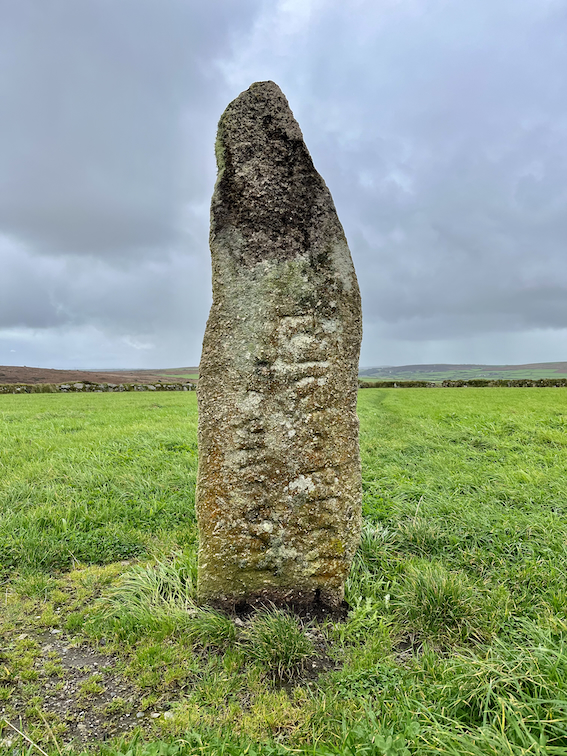Mention Bran alongside crows or ravens, and most people will immediately think of the youngest Stark son in Game of Thrones. GRRM, like most writers, dig around in ancient history and rework old, misshapen pieces into something new.
This blog isn’t about an inquisitive boy who had the misfortune to be pushed out of a window after seeing the Lannister brother and sister humping. Instead, I will explore Cornwall’s ancient past, a 5th-century man who went by the same name, and the Celtic mythology of Bran. So if you like talking heads (actual talking heads, not the band) then keep reading.
Searching for Bran
Our journey begins on The Tinners Way. This ancient trackway most definitely goes back to the Bronze Age and potentially goes back further, to Neolithic times. Countless feet have plodded this route, as I add mine at a spot between Zennor and St Just.
Most walk this route to visit Men-An-Tol. A curious Bronze Age site because it includes a round granite stone with a man-made hole positioned between two upright standing stones. Unfortunately, the layout we currently see is the work of Victorians doing the equivalent of a bad touch-up on an old painting. The site was likely to have been a stone circle or chamber tomb, but the original layout has disappeared and no doubt stones have been repurposed by people over the millennia.

I digress and resume my walk on the ancient trackway to the real reason I’m here: Men Scryfa. The ‘Men’ here is Cornish for ‘stone’. While Men-An-Tol means ‘the stone with a hole’ Men Scryfa means ‘the stone with writing’. The etymology of place names always interests me because despite how evocative they can sound, the meaning boils down to ‘say what you see’. I live in Hayle, which is a port town by an estuary. In Cornwall, it’s spelt Heyl, which means ‘estuary.’
Men Scryfa
Men Scryfa is a Bronze Age standing stone with some intriguing 5th or 6th-century graffiti. In Latinised Cornish, we can still make out the words ‘RIALOBRANI CVNOVALI FILI’ (the FILI part now lies below the surface).
Have you spotted Bran yet?

The inscription translates to ‘Royal Raven, son of the famous leader.’
Ah, so GRRM having Bran in his books interact with a raven makes sense because Bran means ‘raven’. What we have here is a Bronze Age standing stone repurposed as a late Iron Age memorial stone. From the fragmented historical remains and folklore, we are left with a monument and the story of a prince slain while defending his land from unscrupulous interlopers. The standing stone marks where the Royal Raven fell, and marks his six-foot height. Or maybe the standing stone was already there? Maybe he did as Cú Chulainn did from Irish Mythology, and chained himself to the standing stone despite being mortally wounded, and fought to the end?
Where did the Royal Raven gain his name? Now it’s time to dive into some mythology.
Bran the Blessed
In case you misread that, we’re not talking about the actor, Brian Blessed. In Welsh mythology, Bran the Blessed was both a giant and the king of Britain.
Matholwch, an Irish king, visits Bran to ask for his sister Branwen’s hand in marriage. Bran agrees, but celebrations turn sour when Bran’s half-brother, Efnysien (who comes across as violent and antisocial as Begbie in Trainspotting) is enraged that Matholwch didn’t ask him. Efnysien decides to mutilate the Irish King’s horses. Bran offers Matholwch a magical cauldron as compensation, which can restore the dead to life (which seems a bit of an excessive gift, but hey…).
Things settle. Branwen and Matholwch have a son named Gwern. However, Efnysien’s insult rears its ugly head. Matholwch’s advisors convince him to banish his wife to the kitchen where she is mistreated. Branwen tames a starling and ties to its foot a message for her brother, Bran. Upon hearing about his sister’s misery, he puts together a rescue party. Enraged, Bran wades the waters to Ireland (handy being a giant) with his ships filled with warriors behind him.
Matholwch offers to make peace, and houses Bran and his warriors inside a barn where a hundred bags of flour are hanging. Efnysien, either suspecting treachery or because he hasn’t done anything violent in the last hour, discovers the sacks contain hidden Irish warriors. Efnysien goes on a skull-crushing frenzy.
Later, at the feast, Efnysien causes more problems. Slighted by the fact Gwern, his nephew and the Irish King’s son, didn’t greet him, Efnysien threw him into the fire, burning him alive. This doesn’t go down well. A battle ensues, and despite despatching many Irish warriors, they keep coming back. Bran realises they are using the magic cauldron to revive their dead. Playing dead amongst the Irish, Efnysien is unwittingly tossed into the cauldron, where he destroys it from within, sacrificing himself.
Talking Heads
Bran is victorious but at an enormous cost. Only seven in his party survive the fight and he is mortally wounded. He tells them to cut off his head and take it home to Harlech.
In normal terms, this action would be fatal. Not in Bran’s case. He’s still talking and continues talking for the next eighty-seven years, entertaining those who survived the fight. I can imagine him on a shelf in the corner, like a TV, talking away. Those last eighty years go unnoticed by those with Bran until they open the door and their sorrows return. Bran is now silent, and they bury his head on White Hill, where the Tower of London stands. A watchful guardian, warding off invasion. Is it a coincidence that if the infamous ravens in the tower fly away, Britain will perish? Probably, but it’s a good story.
Unfortunately, it is said King Arthur dug up Bran’s head, declaring Britain to be safe while he protected it.
Historically, people widely believed that the head was the seat of the soul, and frequently used it in healing and ritual practices. If you’re a warrior, you’re not only taking booty from your enemy, but their heads too. If you defeated someone famous, well… you’re going to do what you can to preserve their head so you can drag it out at dinners and festive get-togethers to show off to your guests.
Other signs of Bran in Cornwall
Along some narrow roads, you will find a place named Brane (meaning, dwelling of Bran). A short walk uphill takes you to Caer Bran. At first glance, it appears to be an Iron Age hill fort, denuded of its stone by the locals (and probably in a lot of the buildings in nearby Brane). However, surveys suggest it was originally a Bronze Age enclosure. Once again, the Iron Age people are repurposing sites from the Bronze Age past.

Can we link this site to our Royal Raven? Not really. But these brief glimpses and intangible clues left in stone and place names offer excellent fodder for our imagination.

Pingback:Boscawen-ûn Stone Circle – Emma Cox